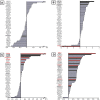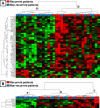Quantification of hypoxia-related gene expression as a potential approach for clinical outcome prediction in breast cancer
- PMID: 28430808
- PMCID: PMC5400273
- DOI: 10.1371/journal.pone.0175960
Quantification of hypoxia-related gene expression as a potential approach for clinical outcome prediction in breast cancer
Abstract
Breast cancers are solid tumors frequently characterized by regions with low oxygen concentrations. Cellular adaptations to hypoxia are mainly determined by "hypoxia inducible factors" that mediate transcriptional modifications involved in drug resistance and tumor progression leading to metastasis and relapse occurrence. In this study, we investigated the prognostic value of hypoxia-related gene expression in breast cancer. A systematic review was conducted to select a set of 45 genes involved in hypoxia signaling pathways and breast tumor progression. Gene expression was quantified by RT-qPCR in a retrospective series of 32 patients with invasive ductal carcinoma. Data were analyzed in relation to classical clinicopathological criteria and relapse occurrence. Coordinated overexpression of selected genes was observed in high-grade and HER2+ tumors. Hierarchical cluster analysis of gene expression significantly segregated relapsed patients (p = 0.008, Chi2 test). All genes (except one) were up-regulated and six markers were significantly expressed in tumors from recurrent patients. The expression of this 6-gene set was used to develop a basic algorithm for identifying recurrent patients according to a risk score of relapse. Analysis of Kaplan-Meier relapse-free survival curves allowed the definition of a threshold score of 2 (p = 0.021, Mantel-Haenszel test). The risk of recurrence was increased by 40% in patients with a high score. In addition to classical prognostic factors, we showed that hypoxic markers have potential prognostic value for outcome and late recurrence prediction, leading to improved treatment decision-making for patients with early-stage invasive breast cancer. It will be necessary to validate the clinical relevance of this prognostic approach through independent studies including larger prospective patient cohorts.
Conflict of interest statement
Figures




References
-
- Sestak I, Cuzick J. Markers for the identification of late breast cancer recurrence. Breast Cancer Res. 17:10 Epub 2015/04/08. doi: 10.1186/s13058-015-0516-0 - DOI - PMC - PubMed
-
- Ahn SG, Lee HM, Cho SH, Bae SJ, Lee SA, Hwang SH, et al. The difference in prognostic factors between early recurrence and late recurrence in estrogen receptor-positive breast cancer: nodal stage differently impacts early and late recurrence. PLoS One. 8(5):e63510 Epub 2013/05/30. doi: 10.1371/journal.pone.0063510 - DOI - PMC - PubMed
-
- Magnon C, Opolon P, Ricard M, Connault E, Ardouin P, Galaup A, et al. Radiation and inhibition of angiogenesis by canstatin synergize to induce HIF-1alpha-mediated tumor apoptotic switch. J Clin Invest. 2007;117(7):1844–55. Epub 2007/06/09. PubMed Central PMCID: PMC1884687. doi: 10.1172/JCI30269 - DOI - PMC - PubMed
-
- Vaupel P, Kelleher DK, Hockel M. Oxygen status of malignant tumors: pathogenesis of hypoxia and significance for tumor therapy. Semin Oncol. 2001;28(2 Suppl 8):29–35. Epub 2001/06/08. - PubMed
MeSH terms
LinkOut - more resources
Full Text Sources
Other Literature Sources
Medical
Research Materials
Miscellaneous

